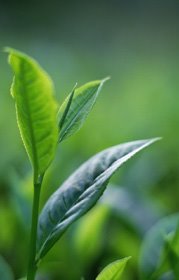
Because of a general lull in work after lunch, before the usual cup I thought it might be prudent to include a post about tea basics.
Doing research is fairly easy nowadays, and there is plenty of information on tea and its preparation. So, I will not bore you with unnecessary scientific details. All you really need to know is that tea is produced by first plucking, ideally, the top two or three leaves of a fully developed tea stalk. In other words: nipped at the bud. (Notice my profile picture, which is the same as the one to the left here.) This tactic not only produces great drinks, it also ensures the maximum amount of output per plant: constant grooming provides for continuous regrowth, if the atmospheric conditions are correct (mostly warm, humid climates). Plucking more than these few leaves can be done, but at a great cost to the quality.
Likewise, based on this and the fact that some companies will sacrifice quality for output, it is naturally recommended that if you plan on being, or already are, a regular tea-drinker, you should try a variety of brands. This not only keeps oneself from being robbed of great tea experiences because of mere convention, but also allows one to find that which suits palate and wallet equally, or in some other preferable balance.
All tea, properly named, is made from the same plant. Black tea is made by crushing the leaves and exposing it to air along with a certain level of heat (called "oxidation and fermentation"). The other kinds of tea are prepared for consumption without these things, with green tea being almost completely untouched. Naturally, this begs the question of how people make little pellets out of unfermented tea leaves (such as the "Gunpowder" tin at your local Peet's), since this treatment could potentially make the unfermented nature tinged. However, it does make for an interesting take on how to prepare the leaves, and merges well into the next point:
Tea can be grown with almost any natural product in the soil as a way to "flavor" it without losing any of the original integrity of the plant or its product. This is why one can have legitimate tea that tastes of, for example, "vanilla caramel" (a flavor put out by Bigelow). However, one should not confuse flavored teas with herbal teas, since herbal teas are not really from the tea plant and thus do not have the same benefits or taste. Herbal "teas" are therefore more often called "infusions" by major manufacturers - probably to keep from getting sued for false representation. :)
So, now you know more on the first step about tea prep. Next time: brewing and drinking!
Doing research is fairly easy nowadays, and there is plenty of information on tea and its preparation. So, I will not bore you with unnecessary scientific details. All you really need to know is that tea is produced by first plucking, ideally, the top two or three leaves of a fully developed tea stalk. In other words: nipped at the bud. (Notice my profile picture, which is the same as the one to the left here.) This tactic not only produces great drinks, it also ensures the maximum amount of output per plant: constant grooming provides for continuous regrowth, if the atmospheric conditions are correct (mostly warm, humid climates). Plucking more than these few leaves can be done, but at a great cost to the quality.
Likewise, based on this and the fact that some companies will sacrifice quality for output, it is naturally recommended that if you plan on being, or already are, a regular tea-drinker, you should try a variety of brands. This not only keeps oneself from being robbed of great tea experiences because of mere convention, but also allows one to find that which suits palate and wallet equally, or in some other preferable balance.
All tea, properly named, is made from the same plant. Black tea is made by crushing the leaves and exposing it to air along with a certain level of heat (called "oxidation and fermentation"). The other kinds of tea are prepared for consumption without these things, with green tea being almost completely untouched. Naturally, this begs the question of how people make little pellets out of unfermented tea leaves (such as the "Gunpowder" tin at your local Peet's), since this treatment could potentially make the unfermented nature tinged. However, it does make for an interesting take on how to prepare the leaves, and merges well into the next point:
Tea can be grown with almost any natural product in the soil as a way to "flavor" it without losing any of the original integrity of the plant or its product. This is why one can have legitimate tea that tastes of, for example, "vanilla caramel" (a flavor put out by Bigelow). However, one should not confuse flavored teas with herbal teas, since herbal teas are not really from the tea plant and thus do not have the same benefits or taste. Herbal "teas" are therefore more often called "infusions" by major manufacturers - probably to keep from getting sued for false representation. :)
So, now you know more on the first step about tea prep. Next time: brewing and drinking!
Cheers,
Michael
***
Quote for pondering:
"May you have walls for the winds,
a roof for the rain,
tea beside the fire,
laughter to cheer you,
those you love near you
and all your heart might desire." - Irish Blessing
Quote for pondering:
"May you have walls for the winds,
a roof for the rain,
tea beside the fire,
laughter to cheer you,
those you love near you
and all your heart might desire." - Irish Blessing







No comments:
Post a Comment